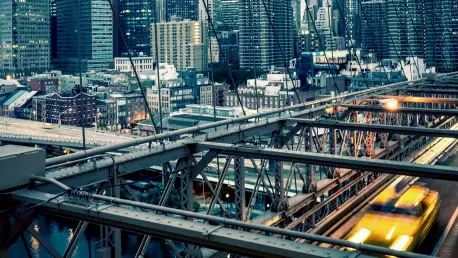There’s an uncomfortable truth most governments ignore: “fixed” is not the same as future-proofed. For decades, America’s repair culture has been reactive—paving over cracks, replacing worn valves, and patching bridges just enough to keep traffic moving. But in an age of climate extremes, rising demand, and rapid technological change, that approach is dangerously outdated.
39% of major U.S. roads are in poor or mediocre condition—just one step from severe deterioration. An estimated 260,000 water main breaks occur annually, costing $2.6 billion in repairs each year. Without a modern approach, another crisis is always around the corner.
This article examines what America’s aging infrastructure really needs to survive the next century, why traditional fixes are no longer enough, and how leading cities are using technology, data, and resilient design to stay ahead of failures.
Quick Fixes Are a Hidden Liability
To start with the obvious: patchwork repairs don’t build resilience. In public works, they don’t just fail to prevent the next breakdown—they can invite cascading problems across systems.
Consider roads and bridges. Heavy traffic and extreme weather events are eroding them faster than traditional maintenance schedules can handle. Resurfacing a road without addressing drainage or using materials built for higher heat means that the next storm or heatwave can undo months of work. A bridge might pass inspection today, but still buckle under tomorrow’s conditions. The American Society of Civil Engineers notes that every $1 invested in resilience saves $13 in disaster recovery—a stark reminder that short-term “done” is often a costly illusion.
In water systems, the same cycle repeats. Pipes laid over a century ago are left in place until they rupture, flooding streets and disrupting service. By restoring infrastructure to its previous state without upgrading it to meet future demands, agencies are locking in vulnerability.
Beyond the visible failures, this reactive mindset erodes public trust, strains budgets, and leaves communities exposed to risks that could have been prevented.
Fix the Problem Before It Breaks
The hard truth is that too many cities still operate in “whack-a-mole” mode—waiting for something to fail before responding. The result? Higher costs, longer outages, and increased safety risks.
Breaking out of this cycle means redefining what “done” looks like. Success can’t just be measured in potholes filled or valves replaced; it must be measured in failures prevented. That requires condition-based maintenance—repairing or upgrading assets based on real-time performance data, not arbitrary timelines.
Take spray-in-place pipe lining, a modern rehabilitation technique that can extend a pipe’s life by decades without major disruption. Cities investing in such methods are not only reducing emergency callouts but also stretching limited budgets further. It’s the infrastructure equivalent of regular check-ups: prevention over crisis care.
But prevention demands foresight—and that calls on the game-changer reshaping infrastructure management: smart technology.
The New Early-Warning System
In the era of smart cities, infrastructure health is a necessity; tiny IoT sensors embedded in bridges, roads, and water mains now monitor strain, vibration, temperature, and flow 24/7, creating a continuous health record.
But sensors alone are just noise without analytics. Advanced data platforms and AI can sift through millions of readings to identify patterns and predict failures before they happen. It’s the difference between replacing a joint before rush-hour gridlock or reinforcing a levee before floodwaters rise.
Take Fayetteville, North Carolina. By applying AI to flood risk data, city officials pinpointed exactly which vulnerable areas to address first. Every dollar stretched further, every intervention was smarter. When deployed with purpose, these technologies transform infrastructure from a reactive liability into a predictive shield.
Building Resilience by Design…
Yesterday’s infrastructure cannot withstand today’s realities. If there’s a lesson from recent years, it’s that. In 2024 alone, the U.S. endured 27 separate billion-dollar disasters, totalling $182 billion. Roads, bridges, and power lines built for a milder climate were pushed to their limits.
Fortifying infrastructure to withstand extreme heat, flooding, and storms while continuing to serve daily needs (Resilient design) is the only viable path forward. That means looking into self-healing concrete, composite coatings, or redundancy systems that keep networks operational even if one component fails.
The payoff is clear: every dollar spent on resilience yields exponential savings in avoided disaster recovery. And the benefits extend beyond emergencies.
Smart cities are already leading here, integrating smart grids, solar-powered backup systems, and green stormwater infrastructure into their planning. This isn’t just building back, but building better.
Redefining “Done”
Transitioning from patch-and-pray to innovate-and-invest requires leadership, vision, and cultural change. Leading agencies share common habits:
They set performance-based goals. A project isn’t “done” until it measurably improves reliability, extends asset life, or reduces outages.
They deploy technology with intent. IoT, AI, and data tools are used to meet specific safety, efficiency, or cost goals—not just for show.
They coordinate across systems. Roadworks align with broadband installation, sewer upgrades, and utility repairs to maximize impact.
They invest in people. Training teams to interpret data and operate modern tools ensures the workforce can identify problems early and propose innovative fixes.
Money alone won’t solve the infrastructure crisis if it’s spent doing things the old way. “Done” must mean future-ready, not just patched.
What Leading Cities Are Doing Right Now…
The most forward-thinking cities aren’t waiting for the next catastrophic failure to force their hand (and so should you). They are:
Doubling down on prevention. Allocating budget to proactive maintenance and predictive repairs rather than crisis response.
Integrating tech and resilience. Using sensors, AI, and new materials to extend asset lifespans and cut lifetime costs.
Aligning projects for impact. Coordinating schedules so that multiple upgrades happen together, reducing disruption and cost.
Preserving flexibility. Maintaining reserve funds for unexpected challenges and being willing to pause or rethink projects if data suggests a better approach.
Through the application of these strategies, you can also set yourself up for success.
Done Right, Not Just Done
You can’t future-proof infrastructure by rebuilding it exactly as it was. Today, in the face of climate threats, demand surges, and budget pressures intersect, reactive fixes are a luxury no city can afford.
In short, if you feed the infrastructure pipeline old assumptions and outdated methods, you’ll get the same fragile results—only now with higher stakes and costs. So, ask, “Will this infrastructure still serve in 20 years under tougher conditions?” Because the real cost of doing otherwise is measured in collapsed bridges and flooded streets.
The smartest cities are already adapting, and it’s time for the rest to follow.









